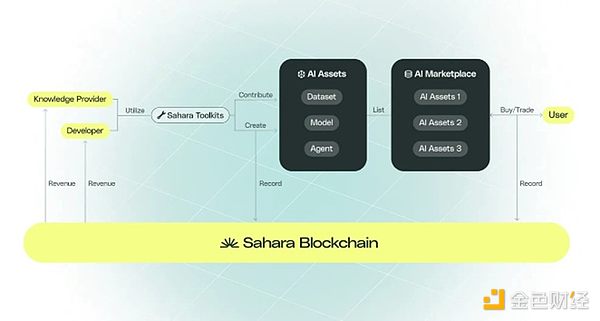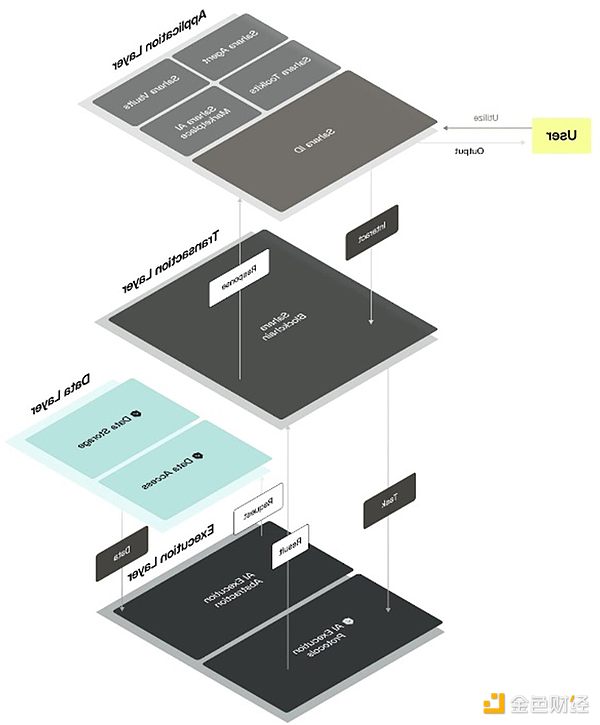By Paul Veradittakit, Partner at Pantera Capital
Compiled by: xiaozou, Golden Finance
Sahara AI's mission is to create a more open, fair, and collaborative AI economy that makes it as easy as possible for people to participate. Using blockchain, Sahara ensures that all contributors (data contributors, labelers, model developers, etc.) are fairly compensated, data and models remain sovereign, AI assets are secure, and permissions can be created, shared, and traded.
1. Current state of the AI stack
The current AI stack can be divided into the following layers:
Data collection and annotation
Data is collected from various sources (e.g. web scraping, public datasets, user-generated data) and must comply with licensing requirements to avoid legal issues. Data is annotated according to the task at hand (e.g. classification, object recognition).
Model training and service
Data is fed into the model, and the model adjusts its internal parameters (weights) to minimize the error. This requires fairly expensive and time-consuming computation.
Creation and deployment of AI agents
Creating a user experience for an AI agent typically involves using tools like TensorFlow and requires technical expertise.
Computing resources
Model training requires expensive processing.
Each layer is highly competitive and diverse, and to a large extent, one way of doing things has proven to be the most effective. For example, data collection is best done using large public datasets (such as books) and fine-tuning is done using specialized data (research papers). Model training is best done on specialized hardware, AI agents should be easy to use with plug-and-play resources to build a developer community, and computing resources should be distributed so that providers of computing resources are accurately rewarded. These combined will lead to better AI models and a stronger community.
Web2 companies are moving in this direction, but face severe limitations due to their centralized architects. From a business and technology perspective, these companies are designed to restrict access and isolate different parts of the stack, resulting in different security standards, database designs, backend integrations, and monetization strategies. In practice, this is poorly designed and ill-equipped to handle the shift in economic models driven by AI.
For example, OpenAI has built a very powerful base model and started attracting community builders through its permissionless GPT wrapper marketplace, but only allows surface-level customization of prompts and does not support refactoring of the underlying model. All of the company’s computing resources were purchased with investor money and it is expected to end the year with a loss of $5 billion.
2. AI Collaborative Economy
The Sahara platform provides a one-stop service for all AI development needs throughout the AI lifecycle: from data collection and annotation, to model training and services, AI agent creation and deployment, multi-agent communication, AI asset trading, and crowdsourcing of AI resources. By democratizing the AI development process and lowering the entry barriers of existing systems, Sahara AI provides equal access to individuals, businesses, and communities to build the future of AI together.

The above diagram summarizes the user journey, depicting how AI assets move from creation to usage to user stickiness in the Sahara AI ecosystem. It is worth noting that all transactions within the platform are immutable and traceable, ownership is protected, and asset provenance is recorded. This supports a transparent and fair revenue sharing model, ensuring that both developers and data providers are appropriately compensated for generating revenue.
Sahara’s goal is to make it easier for people to participate in the AI economy. Developers and users can use Sahara to:
Experienced AI Developers:
Developers can use the Sahara SDK and API to interact with the Sahara blockchain and any layer of its AI stack, such as personalized computing power, data storage, and incentive structures, to form their own Sahara AI agents that can be licensed and monetized for use by others.
New AI developers:
Through a no-code/low-code environment, developers can create and deploy AI assets through an intuitive interface and pre-built templates.
AI Training:
To participate in AI model training, users simply visit a website where they can complete AI training tasks and be compensated in tradable tokens, with tasks ranging from solving basic math problems to describing short videos.
AI Users:
Users can easily use AI agents through an intuitive UI. Users can flexibly purchase licenses for access and further development, and even trade AI asset shares.
Users will be able to create their own personalized data "knowledge base" and create specialized AI using their own data. Just like other AI, this will be accessible to others, while the training data remains completely private and secure.

company:
Companies can also create AI agents (or “business agents”) trained on their own proprietary data, at a much lower cost because the system runs on the Sahara blockchain and benefits from decentralized AI agent generation and services.
Companies can also pay to generate Sahara data, which combines AI-automated and human annotation to effectively create high-quality, privacy-preserving multi-model datasets.
Aside from the enterprise-focused offerings, which are already being used by some high-profile customers, all other features have not yet been released, but are planned for release.
3. Technical Overview

The Sahara team designed the system to be as simple and easy to use as possible, abstracting away the complexity required to ensure compatibility, profitability, and security across all parts of the AI stack. Behind the scenes, the Sahara team developed countless innovations to achieve this goal. Here are a few examples:
- The Sahara blockchain minimizes gas fees and is fully compatible with the EVM. The Sahara Cross-Chain Communication (SCC) protocol enables secure, permissionless data transfer across blockchains, promoting trustless interoperability.
- Sahara AI-Native Precompiles (SAPs) are precompiled smart contracts used to optimize the performance of AI tasks to reduce computing overhead, including training execution SAPs and inference execution SAPs.
- Sahara Blockchain Protocols (SBPs) manage AI assets to ensure accounting responsibility, such as AI Attribution to track contributions and distribute rewards, and AI Asset Registry to manage the registration and provenance of AI assets, AI licenses, and AI ownership.
- Data management is performed both on-chain and off-chain, with AI asset metadata, commitments, and proofs on-chain, while important datasets, AI models, and supplementary information are performed off-chain to optimize data retrieval, security, and data availability.
- Collaborative Execution Protocols support joint AI model development and deployment across AI training, aggregation, and serving. Other models like PEFT allow for technical fine-tuning, Privacy Preserving Compute supports differential privacy, homomorphic encryption, and secret sharing, and Fraud Proofs do what the name suggests.
4. Fully integrated AI stack
The team is led by USC tenured professor Sean Ren, who was named one of MIT Technology Review's 35 Technological Innovators and was named Samsung Fellow in 2023, and UC Berkeley alumnus Tyler Z. Other members of the team have backgrounds or experience from Stanford University, UC Berkeley, AI2, Toloka, Stability AI, Microsoft, Binance, Google, Chainlink, LinkedIn, Avalanche and other companies, contributing valuable expertise.
Sahara is also advised by top AI native researchers and enterprise customers:
- Laksh Vaaman Sehgal (Vice Chairman, Motherson Group)
- Rohan Taori (Human Research Scientist)
- Teknium (co-founder of Nous Research)
- Vipul Prakash (CEO, Together AI)
- Elvis Zhang (founding member of Midjourney)
Sahara AI is currently used by more than 35 leading technology innovation projects and research institutions, including Microsoft, Amazon, MIT, Motherson Group, and Snap, for various AI services such as Shara Data for data collection/annotation and Sahara Agents for personalized domain agents.
Generative AI is still in its infancy in terms of technology and market size; today’s centralized chat and video tools have limited reach due to the difficulty of integrating the entire AI stack into a single product. Sahara AI is the only company addressing this bottleneck with a modular design that uses blockchain as the backbone for permissionless access, token distribution, and security. The future of AI must be accessible and equitable for everyone to participate, and Sahara AI is the only company moving toward that vision.
















